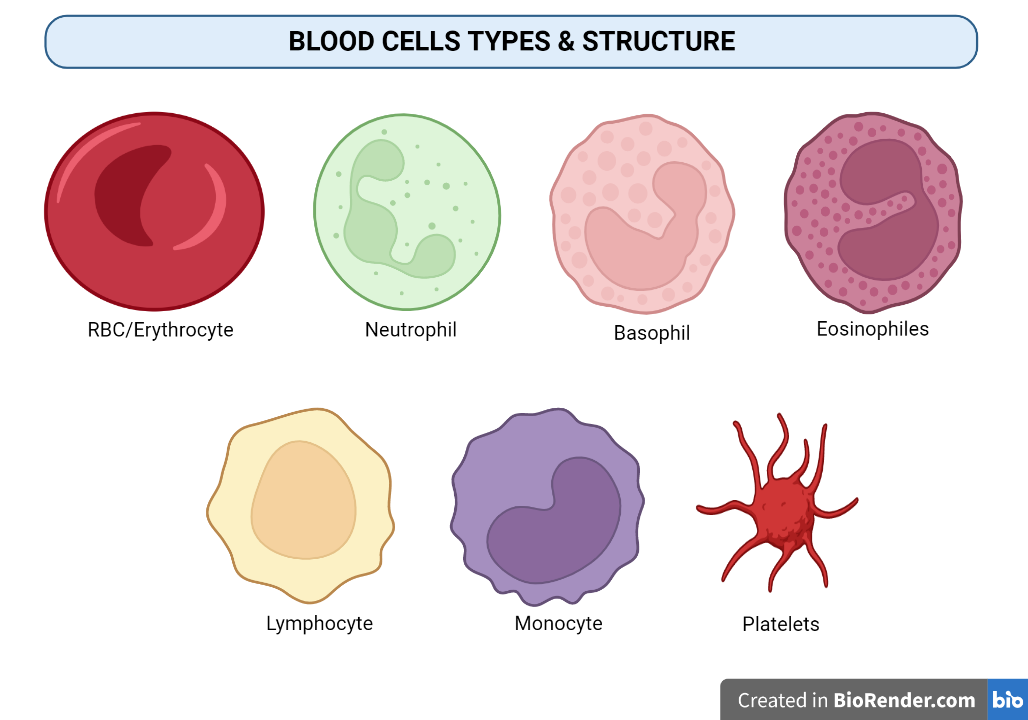Blood, “The River of Life” as it supports life. It contains the nutrients and oxygen that support living organisms. The cells in the blood are generally synthesized in the bone marrow by a process called haematopoiesis. Blood contains three types of blood cells, namely Erythrocytes or RBC, Leukocytes or WBC and Platelets. Almost half of the total blood is composed of blood cells. These cells are developed from the bone marrow.
WBC can be sub-classified into 2 other groups, Granulocytes and Agranulocytes. Agranulocytes are, Lymphocytes and Monocytes. Granulocytes can be sub-classified as neutrophils, basophils, and eosinophils.
The important functions of blood and associated cells are to provide an immunological response, transportation of oxygen to different parts of the body, and repairing of tissues.
List of Blood Cells
- Erythrocytes or RBC
- Leukocytes or WBC
- Platelets
Types of WBC
- Monocytes
- Eosniphil
- Basophil
- Lymphocyte
- Neutrophil
1. Erythrocytes or RBC – Red Blood Cells
- Erythrocytes or Red Blood Cells (RBC) are the major cells present in the blood which contains haemoglobin, a protein that carries oxygen.
- These are the non-nucleated cells having a disc-shaped structure.
- These cells have the primary function of carrying and transporting gases for respiration and nutrients essential for the body.
- These cells have a total life span of 120 days. These cells needed to be replaced with new cells by bone marrow as it cannot divide itself.
- The formation of Erythrocytes is called Erythropoiesis.
Structure & Function
- RBCs can have disc-shaped or biconcave structures.
- These cells have this unique structure that helps in the gaseous exchange.
- This structure also facilitates the Erythrocytes to flow through the blood vessels rapidly due to its flexible nature.
- The concentration of RBC varies in Men and Women. In women, the concentration is 3.8 – 5.2 x 10*12/L and in men, the concentration is 4.0 – 5.9 x 10*12/L.
- It has a structure filled with a protein called haemoglobin which helps in carrying oxygen and gaseous exchange. A healthy individual’s blood has 12 to 20 grams of haemoglobin in 100mL of blood.
Read the detailed structure and function of erythrocytes or RBC
- The major function of the RBC is to carry respiratory gases like oxygen and carbon dioxide for energy production by ATP synthesis.
- Transportation and supply of some essential nutrients.
2. Leukocytes or WBC – White Blood Cells
- Leukocytes are the defensive system of the body that supports the immune system.
- These cells help in the defence against an external body that causes infection by phagocytosis, antibody production, etc.
- Two major groups of Leukocytes are; granulocytes and agranulocytes.
- WBC is a colourless cell but can appear in a purple or blue colour when it is stained for microscopic observation.
- Leukocytes are formed from the bone marrow.
- Two types of Leukocytes grow in Thymus called T Cells and the Lymph nodes and spleen called B Cells develops in bone marrow.
Types of WBC
- Neutrophils: Major function of Neutrophils is the defence against infection. It helps to protect the body from infections from Fungi, Bacteria and other external bodies.
- Basophils: Basophils are the reason for allergic responses. It is a part of the immune response when a foreign body enters the body. Major allergic responses like sneezing, coughing, etc.
- Eosinophils: Major function of Eosinophils is to assist Basophils with allergic responses against parasites.
- Lymphocytes: It contains the earlier mentioned T cells and B Cells. It protects against viral infections.
- Monocytes: They have a cleaning function. It protects the body from damaged cells. Monocytes can be subdivided into dendritic cells and macrophages. Monocytes play a major role in the activation of the B Cells. This can contain lysosomes for the digestion of dead cells.
3. Platelets
- Platelets are also known as thrombocytes. These are the non-nucleated structures similar to RBC.
- The major function of platelets is the clotting or coagulation of blood during cuts or injuries.
- The surface of platelets contains small granules. Which plays a major role in the clotting of the blood.
- A specific protein from the liver called as thrombopoietin plays a major role in the production of Platelets.
Last updated:
Graduated from the University of Kerala with B.Sc. Botany and Biotechnology. M.Sc. Biotechnology from the University of Kerala. Attended certificate course in Artificial Intelligence for Everyone from Deeplearning.AI, Influenza Prevention and Control from World Health Organization. Attended workshops related to Bioinformatics at the University of Kerala. 3 years of experience in website management. Experience in WordPress, Blogger, Google Analytics, and Google Search Console.










